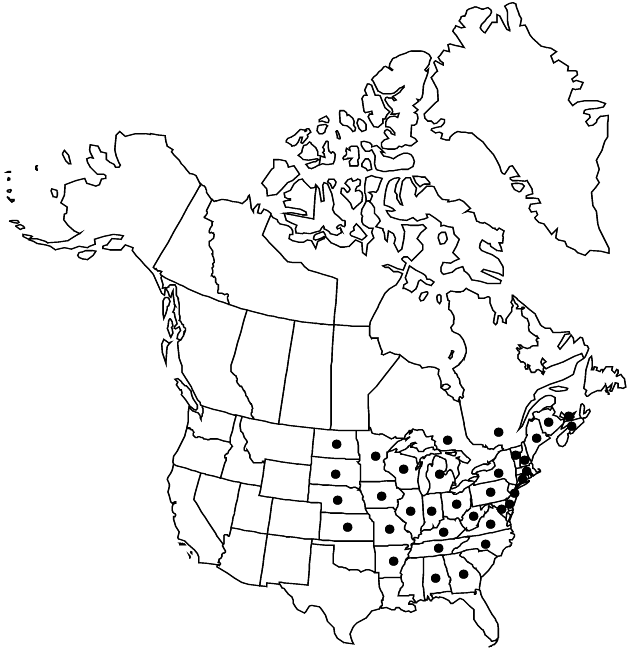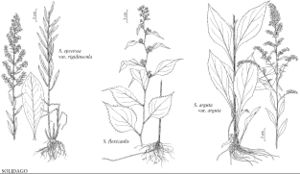Solidago flexicaulis
Sp. Pl. 2: 879. 1753.
Plants (15–) 25–75 (–90) cm; caudices woody, rhizomes short. Stems 1–5+, flexuous, sparsely to moderately hairy in arrays. Leaves: rosettes present at flowering; basal and proximal cauline tapering to winged petioles, blades ovate, (70–) 100–140 (–180) × (27–) 40–60 (–80) mm (petioles 1/4–1/2 total leaf length), margins serrate-serrulate [teeth (14–) 21–33 (–45)], abaxial faces glabrous or moderately hairy, more densely so on nerves, adaxial glabrous or sparsely hairy; mid to distal cauline sessile, blades narrowly ovate to lanceolate, 38–90 (–150) × 10–30 (–55) mm, reduced distally, becoming lanceolate in arrays, bases tapering, margins entire to serrate, apices acuminate to cuspidate, faces glabrous or sparsely hairy, abaxial glabrous or moderately hairy, more densely so along nerves. Heads 25–250, in short axillary and terminal racemiform clusters, lateral panicles (2–) 7–31 (–56) cm. Peduncles 0.5–5 mm, moderately to densely strigose; bracteoles 1–3, lanceolate, usually near base of involucres and grading into phyllaries. Involucres campanulate, 4.5–7 (–8) mm. Phyllaries in ca. 3 series, strongly unequal, outermost 1–2 mm, innermost 3.7–4.7 (–5.7) mm, linear-oblong, 1-nerved, apices obtuse to acute. Ray-florets 1–5; laminae (2–) 2.5–4 (–5) × 0.7–2 mm. Disc-florets 4–8 (–11); corollas 2–3 (–4) mm, lobes 1–1.6 (–2) mm. Cypselae (obconic) 1–2 (–3) mm, moderately to densely strigose; pappi 3–4.5 mm. 2n = 18, 36.
Phenology: Flowering Aug–Oct.
Habitat: Shaded woods and thickets
Elevation: 0–1200+ m
Distribution

N.B., N.S., Ont., P.E.I., Que., Ala., Ark., Conn., Del., Ga., Ill., Ind., Iowa, Kans., Ky., Maine, Md., Mass., Mich., Minn., Mo., Nebr., N.H., N.J., N.Y., N.C., N.Dak., Ohio, Pa., S.Dak., Tenn., Vt., Va., W.Va., Wis.
Discussion
The two cytotypes of Solidago flexicaulis show a strong geographic pattern. Diploids mostly occur east of the Appalachians except in the southwestern portion of the range, while tetraploids occur west of the mountains (J. G. Chmielewski and J. C. Semple 1985). The report of 2n = 90 for the species (Semple et al. 1993) was based on a specimen of the recently described Solidago faucibus. The significance of ploidy level on cypselae traits was analyzed in detail by Chmielewski et al. (1989).
Selected References
None.
